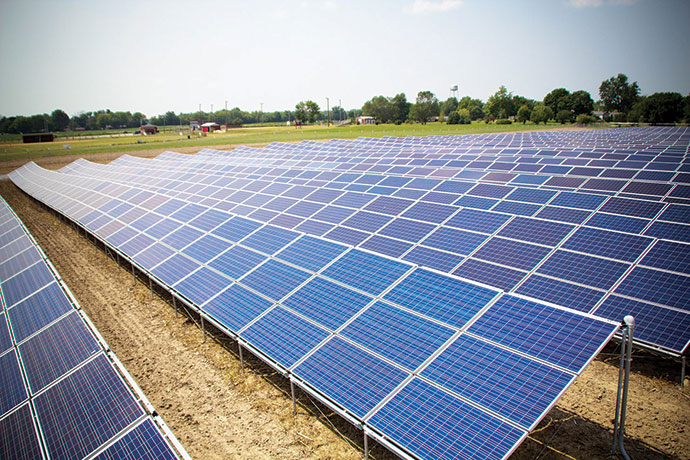When you think of sunshine and solar power, what is the first state that comes to mind? Arizona? California? Florida? New Mexico? Texas?
A municipal power provider in the Midwest would like you to think of one state you likely overlooked: Indiana.
The Indiana Municipal Power Agency (IMPA) is smashing stereotypes about the Midwest and, more importantly, saving industrial power customers a lot of money by making solar energy widely available throughout the utility’s 61 communities statewide.
From Kingsford Heights in far northeastern Indiana to Tell City on the southern border, and in 59 other towns in between, IMPA is changing the way people think about Indiana by making renewable solar energy a regular and reliable source of solar power.
Carmel-based IMPA is taking advantage of Indiana’s yearly average of 186 sunny days by incentivizing companies to locate in an IMPA community and tap into the solar grid. Under IMPA’s Green Power Program, customers can choose to make a monthly renewable purchase at a cost of $.00075 per kilowatt-hour per month. These renewable purchases directly support green energy efforts statewide and ensure that the customers’ energy usage is offset by environmentally friendly generation.
IMPA, which provides some of the lowest industrial power rates in the Midwest, also offers an Economic Development Rider (EDR) incentive to companies that meet the following criteria:
- The business site or building must be located within IMPA service territory.
- The customer must invest a minimum of $1 million in real and/or personal property.
- The project must add a minimum of 1 megawatt (MW) of new connected load at one premise.
The EDR price markdown for qualifying and approved customers equates to 20% for the first year, 15% for year two, 10% for years three and four, and 5% for year five.
IMPA Tops 100 MW Threshold
IMPA is a joint action agency that has served as a wholesale power provider in the Midwest since 1983. With over $2 billion in assets, IMPA generates its electricity from a fuel mix comprising 68.6% coal, 18.4% nuclear, 6.5% natural gas, and 6.5% renewables.
IMPA surpassed 100 MW of solar power recently with the commissioning of the Richmond 4 Solar Park in eastern Indiana. Since 2014, IMPA has developed solar parks throughout the state to further its mission to supply low-cost, reliable, and environmentally responsible power to its 61 members. Now, the 32 solar parks constructed by IMPA collectively provide 106 MW of solar capacity in Indiana.
“IMPA has much better rates than the large investor-owned utilities. In terms of cents per kilowatt-hour, the savings to customers are significant. We stack up very well against all competitors.”
One of its newest parks went online in Crawfordsville, a 16,000-resident city 45 minutes northwest of Indianapolis and two hours from Chicago.
Five solar parks in the community enable generation of 28 MW per day of electric energy. The city’s daily consumption is approximately 50 MW.
“Over half of our capacity can be produced in renewables,” says Crawfordsville Mayor Todd Barton. “When we talk to site selectors, we capitalize on that. Your electricity can come off this solar grid. We are looking at business sites for that right next to our solar parks. We have a few sites left, but we are looking to acquire more ground that we can control. Plus, the five solar parks are geographically distributed in our system.”
Barton adds that “all of the power produced in our solar parks is used right here in Crawfordsville in our system. Because it is used here, we are not paying transmission fees to push it into the grid. The fact that the energy is used locally makes us more cost competitive.”
Industrial customers love that benefit, the mayor notes. “IMPA has much better rates than the large investor-owned utilities. In terms of cents per kilowatt-hour, the savings to customers are significant. We stack up very well against all competitors.”
Barton adds that by becoming one of the first Midwestern cities to be powered mostly by the sun, Crawfordsville is returning to its roots. “We are a small city in Indiana with a long, rich history,” he says. “We were one of the first cities in the state to be electrified. We had a coal-fired power plant long before most cities did. We were very competitive back then. Now, our industrial base is very diverse. That is our strength.”
Utility Drives Industrial Diversification
Crawfordsville may be small, but it is mighty, says the mayor. A steel mill, Kroger cheese plant, large printing company, and a corrugated cardboard manufacturer are just a few of the many manufacturers that call this western Indiana town home.
“We also have mobile integrated health-care and a cutting-edge opioid addiction treatment program,” Barton says. “From prenatal care to chronic disease treatment, Crawfordsville is a leader in these health-care fields in the Midwest.”
Raj Rao, President and CEO of IMPA, says that examples like Crawfordsville will proliferate throughout Indiana as his company continues to invest into more renewable facilities statewide. “For over 35 years, IMPA has provided a low-cost, reliable, and environmentally responsible power supply to our member communities. We are proud to be a leader in solar development in the Midwest, with the establishment of over 30 solar parks throughout Indiana,” Rao says. “These parks serve to diversify our power resources and are yet another community benefit to tout for quality of life and economic development purposes. We are certain the parks will have a lasting impact on the communities we serve.”
As companies continue to evaluate their own sustainability goals, the folks at IMPA are betting on the fact that where companies buy their electricity will increasingly become a decisive factor in site selection. And in Indiana, nowadays that means banking on the sun.
This Investment Profile was prepared under the auspices of the Indiana Municipal Power Agency. For more information, contact Jenny Hartley of IMPA at 317-805-5592 or jennyh@impa.com. On the web, go to www.impa.com.

